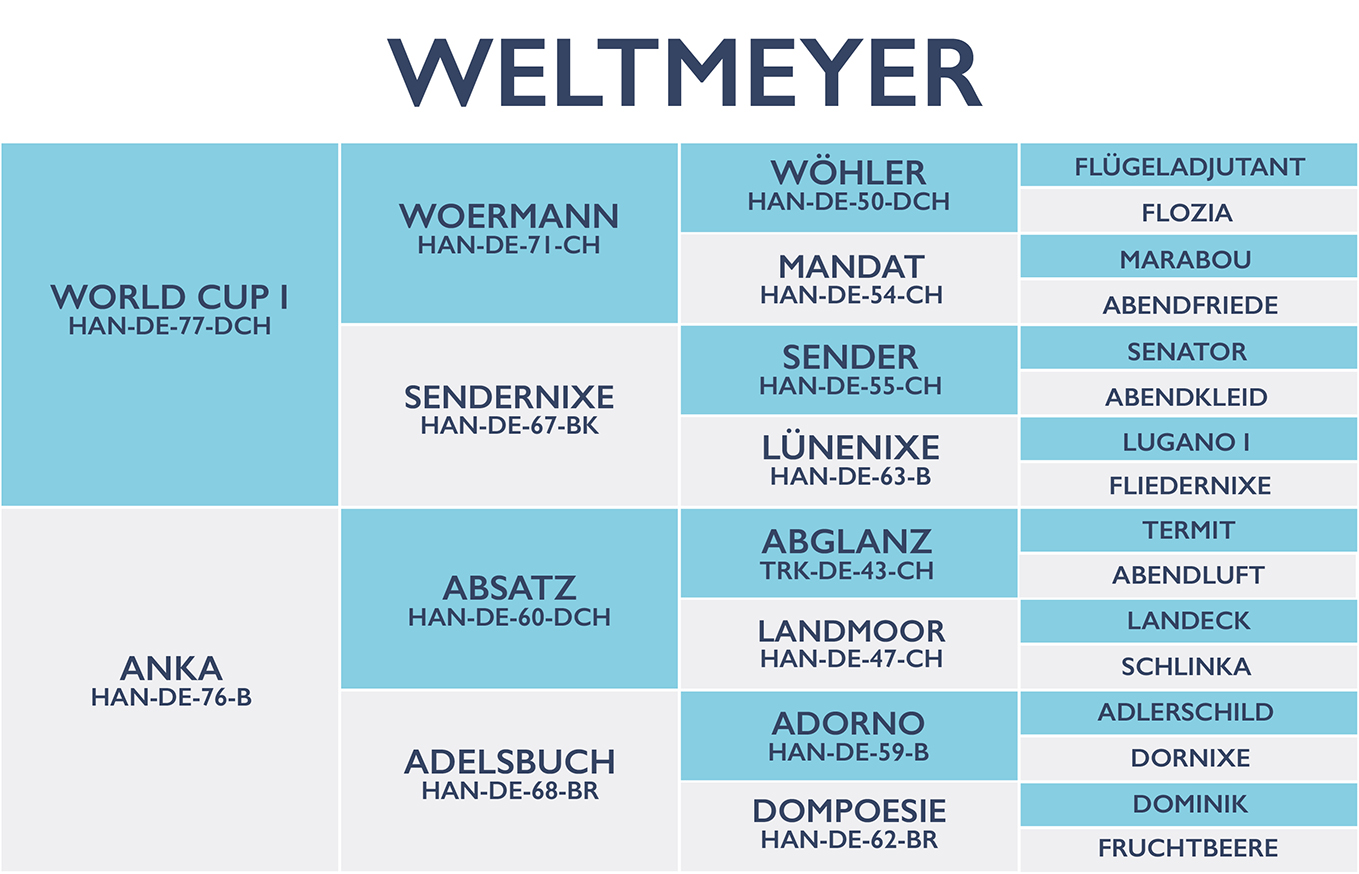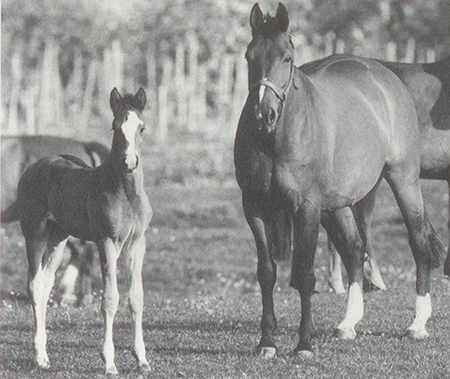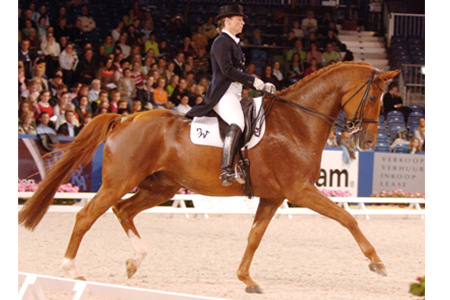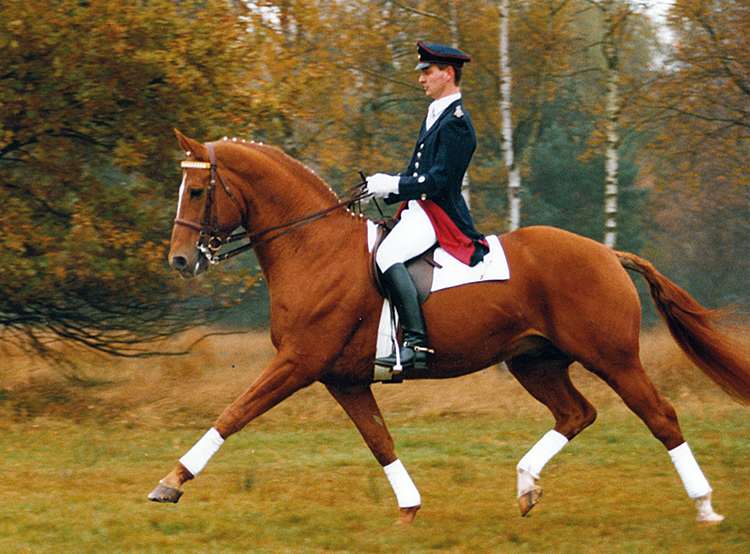
1984 –2011 166 cm Chestnut
Breeder: Hermann Meyer
Weltmeyer was a sensation the day he was born, according to his breeder, Hermann Meyer, and he proved Mr Meyer right when he was champion of his licensing in Verden.
Weltmeyer’s dam, Anka
Incidentally, it is from Mr Meyer that Weltmeyer gets his name – ‘Meyer’ which is about as common in Germany as ‘Smith’ in England, and means something like ‘dairyman’. As the Hanoverian heavies were celebrating Weltmeyer’s win at the licensing with a few hefty glasses of schnapps, they were contemplating an appropriate name, what about World Champion? Great, till someone remembered it had been taken, ah they said, the schnapps cutting in now, we’ll call him Weltmeyer – so Worlddairyman it was… I guess the story is funnier in German, with the schnapps.
At the Bundeschampionate, Weltmeyer continued his triumphal progress. According to deputy breeding director of the Hannoverian Verband, Dr Ludwig Christmann: “He moved through the arena unflustered. His trot was magnificent. It could not have been any better. The judging committee gave him the top score of 10. His canter stride was a leap forward flowing through the entire body of the horse. It earned a 9.5. The walk was ground-covering and earned an 8.0 (if there is a little worry about the Weltmeyer progeny it is in the area of the walk). In addition he received a 9.5 for conformation and for his overall impression.”
One of the few ‘doubters’ at the time was Westfalien born, bred and based, Johann Hinnemann who as the test rider for the ride off at the Bundeschampionate, awarded Weltmeyer a score so low that the announcer declined to read it out, suggesting that the rider could reveal his score – and the reasoning behind it.
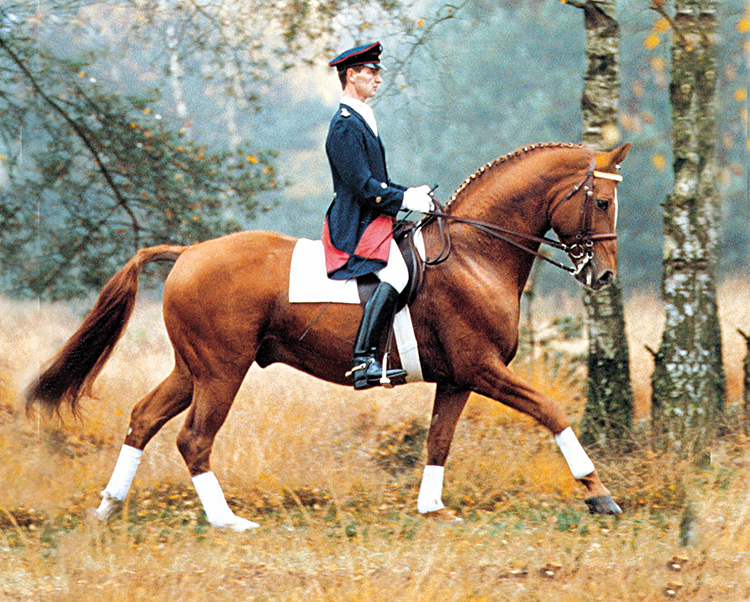
Years later, with Weltmeyer an acknowledged champion sire, Jo told me he was unrepentant:
“I have still not changed my mind. The director of the Hanoverian Stud, Dr Bade was very angry when we gave Weltmeyer low marks after riding him but we had to judge a riding horse competition and not a stallion competition. Weltmeyer is a monument of a horse, and he will produce – especially I think in the second generation – very good riding horses, which will bring breeding a step forward. But when I rode him at the Bundeschampionate in my opinion, he was a horse that was uncomfortable to ride, He had a 15 walk, a 15 trot and a canter for 15, you couldn’t handle that. He gave a lot of energy and perfect basic gaits to his offspring, and they were very successful at the Bundeschampionate, and now I have some horses here that have Weltmeyer as a grandfather and I am enthusiastic about that.”
Weltmeyer went on the win his performance test at Adelheidsdorf with a dressage score of 143.94 – more surprisingly he had a jumping score of 141.44.
With the huge demand from mare owners for Weltmeyer, state stud director, Dr Bade took the unprecedented step of not sending Weltmeyer out to a stallion station, but keeping him at the breeding station in Celle where he was bred to 200 main studbook and State Premium mares from all over the Hannoverian breeding district. This was a ‘kick start’ the like of which no other first season stallion had received, and there are still those who question Weltmeyer’s success, claiming that it comes in no small part from the superior mares he covered.
Still there is no doubt that Weltmeyer is a sensation as a breeding stallion. In 1991, a colt from his first crop, Wittinger (out of a mare by Raphael) was champion of his licensing, and went on the following year – like his dad – to win the title at the Bundeschampionate, and his performance test.
At the 1992 licensing, Wolkenstein II (out of a mare by Wendekreis) was reserve champion, and then won his performance test the following year, the year in which Wolkentanz won his licensing and he too went on to win at the Bundeschampionate, and stand reserve champion at his performance test.
According to the rider who has been with him all his life, Hans-Peter Klaus: “Weltmeyer has fantastic basic gaits. And it is something very special to ride such an eye-catching horse, especially while he is trotting. When he was a young horse his movements were extremely elastic and powerful. I am always very impressed by his willingness to learn and to do a good job. When Weltmeyer was young, he was a bit difficult to handle, but it was better when he matured. Weltmeyer passes this attitude and the spectacular trot to his offspring. All ‘Weltmeyers’ want to be ridden and they ask for work. People enjoy riding Weltmeyer’s sons and daughters, they are very suitable for ambitious riders.”
According to the Hanoverian Verband Breeding director, Dr Jochen Wilkens, who handed over the job to Werner Schade in 2006, of all the stallions during his time as director, Weltmeyer has been the most important:
“For the dressage horses, Weltmeyer has been the most influential. He is now 21 years old, and he has brought to the Hanoverian breed, firstly typiness. He himself is of a refined type and I think it comes from his mother, who is by Absatz, so he gives his type. Another point is that he gives us that big step in trot – they are very elastic and very engaged. The canter is good, a little weak point is the walk. Some of the offspring are not so optimal in the walk, but altogether, from the point of dressage, he is the stallion of his time.”
Which of his sons and grandsons will be the most important heirs of Weltmeyer?
“This is another difficult question. There is Wolkenstein and Wolkentanz, both are in the breed for a long time. Wolkenstein gives a little more jumping ability, I think he is one of the few Weltmeyers to do this. Wolkentanz, tremendous good rideability, and very engaged in all three gaits. Of the younger stallions, Worldly I think is a very interesting horse with Brentano on the mother side. At this stage I think he is the most interesting son of Weltmeyer.” (It seems this was not one of Dr Wilkens’ more astute predictions. Worldly left Germany in 2006, floating around the world, in France, New Zealand, even for a while in Australia. Back in Germany he left 339 competitors, 36 at S level, only one with earnings of more than €10,000 – Wingado with €15,170 – and a Hanoverian dressage value of 115 which does not get him onto the topliste.)
In 1997 Weltmeyer’s first grandsons made their appearance with Welser (by Wolkenstein II, mare by Lanthan) reserve champion at the licensing, while the following year, Waterford (again by Wolkenstein II, mare by Matcho AA) won his licensing and Welser placed second in the performance test.
Weltmeyer, according to the 2014 Hanoverian Stallion book, had produced 86 licensed sons. Even the Hanoverian officials are now admitting that Weltmeyer was something of a disappointment as a sire of sires, and no stallion has really emerged to carry on his line.
They are now pointing to his value as a sire of broodmares, and the cross Donnerhall/Weltmeyer has produced some very nice horses. However I am indebted to my Canadian colleague, Judy Wardrope (www.jwequine.com) for the observation that there are some stallions who just have to become great brood mare sires because of the quality of the mares sent to them. Her example was Secretariat, who covered almost every top American Thoroughbred broodmare and ended up recognized as a brood mare sire without a lot of star performers. I guess the situation is the same with Weltmeyer, he had access to most of Hanover’s top mare lines and his chances of siring good brood mares were greatly magnified.
Weltmeyer is no freak, he comes from one of the most successful dressage families in the world, the ‘W’ family that begins with Woermann. For mine, one of the most exciting things Weltmeyer does (in common with most of the good ‘W’ stallions) is stamp his offspring with a wonderful hock action, instantly cleanly forward and under the centre of gravity – none of that ‘out behind’ coach horse action of earlier times.
The other great thing about Weltmeyer is the potency of his semen, even when he was 19, the manager of his breeding station told me that they were getting between 10 and 15 serves from each collect, and his frozen semen was for a long time consistently the best on the market.
According to Dr Ludwig Christmann of the Hanoverian Verband: “Weltmeyer is one of those stallions that are born only rarely – Absatz, Bolero, Weltmeyer – they leave their mark on the offspring, they are timeless. It is just not possible to reproduce such a stallion, you can try to breed them, but everything has to click and fit for it to happen. He is the number one stallion.”
The criticism of Weltmeyer is always that the horses won’t collect, that there are 5000 offspring, where are they in Grand Prix?
“There are Weltmeyer offspring in Grand Prix. Weltmeyer definitely has his place in the breeding of dressage horses because of the active hind end he produces, and the regularity with which he produces that movement. It is also a question of how many Grand Prix riders we have.”
“I think if Weltmeyer has the right partners, then he produces Grand Prix horses.”
What are the right partners for Weltmeyer?
“For most breeders the first aim is to produce sellable riding horses, not many are looking to produce a Grand Prix dressage horse, they want a talented riding horse with three good gaits and rideability. We find that Weltmeyer works well with mares with Thoroughbred blood, he has always worked well with Bolero, and he also seems to work well with Lauries Crusador. He himself is not a refining stallion and he is not a stallion to put longer legs on the offspring. Sometimes the walk could be better for the Weltmeyer offspring. So I would say long legged mares with a certain proportion of Thoroughbred blood.”
An international competitor with Isabell Werth – Warum Nicht
Weltmeyer has already produced an Olympic representative in the form of Rosemount Wallstreet which perhaps answers some of those who run the line that while the Weltmeyers are very fancy moving young horses ‘of course they will never collect’. In fact, Weltmeyer almost had two representatives at the Sydney Olympic Games, the stallion Wie Weltmeyer was long listed for British selection, but the general feeling is that it was more the inexperience of his British rider, Emma Hindle that kept him out of the team than any lack of horse talent. Martin Schaudt and Weltall, made the German team – while the huge chestnut son of Weltmeyer, Warum Nicht, has been a Grand Prix competitor with Isabell Werth – and he has a double cross of ‘W’ being out of a Wenzel mare.
The 2014 Hannoverian Stallion Book records 1629 competitors, with a total earnings of €2,590,633 – of these there were 1309 dressage competitors (196 at S level). His breeding ranking based on mare tests and auction selections reveals a dressage score of 144, with 163 for his trot. For type he rates 127 and for his limbs he has a rating of 139. His FN ranking is 145 (dressage) and 61 (jumping).
On the WBFSH standings for 2007, Weltmeyer was second place, with 11 representatives, the most successful of which is Isabell Werth’s Warum Nicht, however he gradually slipped down the last, and in 2011, was not in the top ten, although his son, Welt Hit II was 9th. In the 2013 rankings, there is no W line stallion in the top ten. On the 2014 WBFSH standings Weltmeyer has slipped to 42nd place.
In the 2015 Hanoverian stallion book, Weltmeyer is recorded with 1652 competitors with winnings of €2,638,035, with 201 competing at S level dressage. He has 21 dressage horses with winnings of over €10,000, the most successful of these has been Warum nicht with €738,362, with Weltall in 2nd with €204,851. Weltmeyer is the sire of 86 licensed sons.
He has an FN dressage breeding value of 144 and a jumping value of 60. His Hanoverian dressage value is 141 and his jumping value is 73.
In the 2017 Hanoverian Stallion book, Weltmeyer has 1670 competitors with winnings of €2,693,135. 209 have competed at S level, with 22 dressage competitors that have won more than €10,000. The most successful has been Warum Nicht with €738,362, followed by Weltall with €204,851.
He is ranked equally on the new FN breeding values – 138 for young horse, 136 for open competition (for an explanation of these click) On the 2017 Hanoverian values, he scores 140 for dressage, 73 for jumping and 140 for type.
The 2018 Hanoverian book, records Weltmeyer with 1684 competitors, and €2,717,620 in winnings. Twenty two of his dressage competitors earned over €10,000, with Warum Nicht the major source of income with €738,362, the next highest, Weltall on €204,851, then it drops rapidly away with Weserperle the next best on €44,452. He is the sire of 86 licensed sons, 42 in the Hanoverian book, so he certainly had every chance to establish a sire line, but really didn’t. His most successful son would seem to be Welt Hit II – out of a mare by the Thoroughbred, Hill Hawk xx.
Weltmeyer’s 2018 Hanoverian dressage value is 138, which would put him 8th on the Hanoverian topliste if he was eligible to be included, that is just behind Foundation… He scores 124 for type (a negative 99 for his head), 139 for limbs. Back in the 1999 Hanoverian stallion book, with Weltmeyer as Stallion of the Year on the cover, his dressage value was 184, his score for type 169, and even the score for the head was an impressive 137. His dressage value was 184! Those were the days…
Weltmeyer’s 2017 FN breeding value for young horse competitors is 137, for open competition, 136.
In the 2019 Hanoverian book, he has 1691 competitors, 213 at S level dressage, and €2,734,883 in prizemoney, with 23 of his progeny earning more than €10,000 in the dressage arena. Easily the most successful was Warum nicht FRH with €738,362. His Hanoverian value for dressage is 137, jumping, 73. Weltmeyer scores 122 for type. His FN breeding value for young horses is 136, and the same for open competition.
